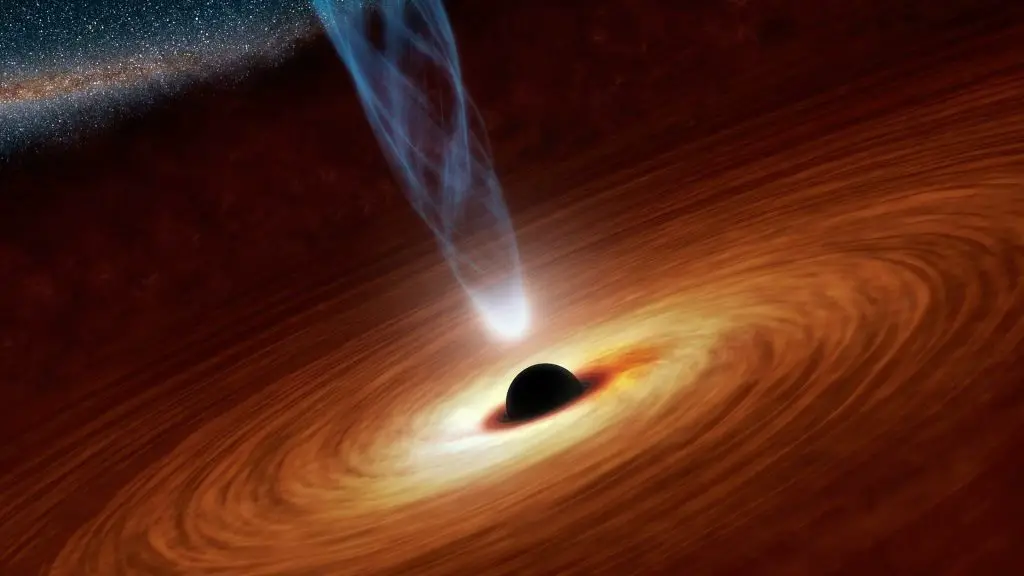The Universe never ceases to amaze our scientists with its uniqueness and the movement of cosmic objects within it. Astronomers recently discovered a runaway supermassive black hole racing through space with a chain of stars after being ejected from its home galaxy. The team was fascinated by the movement of the supermassive rogue black hole through space with its companion of newborn stars following behind it. This fascinating discovery made by astronomers was the first observational evidence that supermassive black holes can be pushed out from their home galaxies to move aimlessly across interstellar space.
How the scientists discovered the rogue supermassive black hole roaming around the interstellar space
Astronomers recently spotted the runaway black hole while they were observing the dwarf galaxy RCP 28 which is located about 7.5 billion light-years from Earth using Hubble Space Telescope. The rogue black hole was seen as a bright streak of light measuring more than 200,000 light-years across.
This massive size is twice the width of the Milky Way. Scientists assume this gigantic supermassive cosmic object to be made of compressed gas that is actively forming newborn stars. The runaway black hole is estimated to measure about 20 million times the mass of the sun. it is traveling away from its host galaxy at 3.5 million mph (5.6 million km/h).
The researchers reveal that the streak of light points exactly right to the galactic center where a supermassive black hole is expected to occupy. Does it mean that the rogue black hole was previously a supermassive black hole holding a galaxy together? Well, scientists that conducted the study explained what they discovered about the black hole to Live Science.
“We found a thin line in a Hubble image that is pointing to the center of a galaxy,” lead study author Pieter van Dokkum, a professor of physics and astronomy at Yale University, told Live Science. “Using the Keck telescope in Hawaii, we found that the line and the galaxy are connected. From a detailed analysis of the feature, we inferred that we are seeing a very massive black hole that was ejected from the galaxy, leaving a trail of gas and newly formed stars in its wake.”
How Scientists confirmed the tail of the ejected black hole
Scientific discoveries like this often raise serious debate among scientists. However, astronomers that made this discovery are confident with their scientific observations. Most gigantic galaxies often host supermassive black holes at their galactic centers. Scientists have discovered that active supermassive black holes usually eject jets of material at extremely high speeds.
This ejection of material is classified as an astrophysical jet and astronomers spotted it as streaks of light in this latest discovery. Van Dokkum and his colleagues studied carefully studied this streak of light to ensure that it is not an astrophysical jet. As astrophysical jets become weaker, they tend to travel away from their originating source of emission. The researchers revealed that this spotted black hole’s tail becomes stronger as it moves away from its galactic origin.
Unlike astrophysical jets that fan out from their originating source, this spotted trail appears to remain linear. The team finalized that the best match for the streak of light is actually a supermassive blackhole traveling through the gas surrounding its home galaxy. The runaway black hole was even able to compress the gas enough which led to a new star formation.
“If confirmed, it would be the first time that we have clear evidence that supermassive black holes can escape from galaxies,” van Dokkum said.
Dokkum’s statement implies that more observations are still required to finally confirm what makes the supermassive black hole ejected from its home galaxy.
What Astronomers may be planning next for further observations
Astronomers will likely be conducting more scientific observations in this region of space to learn how such a massive cosmic object will be eliminated from its host galaxy to roam aimlessly in interstellar space.
“The most likely scenario that explains everything we’ve seen is a slingshot, caused by a three-body interaction,” van Dokkum said. “When three similar-mass bodies gravitationally interact, the interaction does not lead to a stable configuration but usually to the formation of a binary and the ejection of the third body.”
The scientist is suggesting that the runaway black hole might once be part of a rare supermassive black hole binary. However, as a third supermassive black hole was introduced during a galactic merger, one of its already existing black holes was thrown out to create room for the new cosmic object.
“Ejected supermassive black holes had been predicted for 50 years but none have been unambiguously seen,” van Dokkum said “Most theorists think that there should be many out there.”
Dokkum believed that conducting further observations with other telescopes will unlock more mysteries about this region of space. Astronomers that participated in this study published their findings on the pre-print server arXiv.org. it has already been accepted for publication in The Astrophysical Journal Letters.
Conclusion
Scientific discoveries like this often inspire astronomers to conduct further observations in space. We hope to find out the actual reason behind this runaway black hole in future observations. What do you think about this fascinating discovery?




